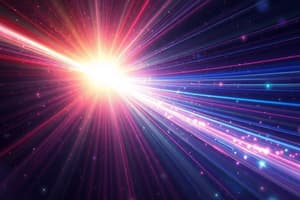Podcast
Questions and Answers
What is the photoelectric effect?
What is the photoelectric effect?
The photoelectric effect is the emission of electrons when electromagnetic radiation, such as light, hits a material.
What are photoelectrons?
What are photoelectrons?
Electrons emitted when electromagnetic radiation hits a material are called photoelectrons.
In which fields is the photoelectric effect studied?
In which fields is the photoelectric effect studied?
The photoelectric effect is studied in condensed matter physics, solid state, and quantum chemistry.
How do the experimental results of the photoelectric effect disagree with classical electromagnetism?
How do the experimental results of the photoelectric effect disagree with classical electromagnetism?
What did Albert Einstein propose about the nature of light in relation to the photoelectric effect?
What did Albert Einstein propose about the nature of light in relation to the photoelectric effect?
Flashcards are hidden until you start studying
Study Notes
The Photoelectric Effect
- The photoelectric effect is a phenomenon where light hitting a metal surface can eject electrons from the metal.
- The ejected electrons are called photoelectrons.
Fields of Study
- The photoelectric effect is studied in fields such as physics, chemistry, and materials science.
Disagreement with Classical Electromagnetism
- Experimental results of the photoelectric effect disagree with classical electromagnetism, which predicts that the energy of the electrons ejected should depend on the intensity of the light, not its frequency.
- However, experiments show that the energy of the photoelectrons depends on the frequency, not the intensity, of the light.
Einstein's Proposal
- Albert Einstein proposed that light is composed of particles (now called photons), which have both wave-like and particle-like properties.
- He suggested that the energy of the photons is dependent on their frequency, which explained the experimental results of the photoelectric effect.
Studying That Suits You
Use AI to generate personalized quizzes and flashcards to suit your learning preferences.




